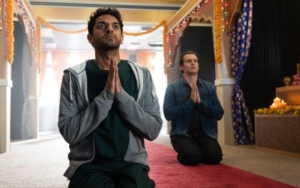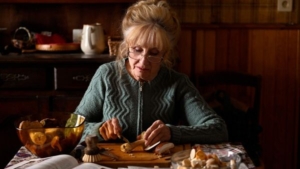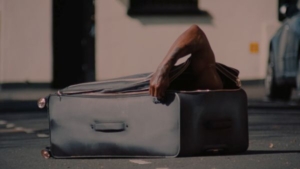![]() A crowd of disturbed faces and exhausted bodies is guided by off-camera voices. The camera captures their stressful march in a dark, claustrophobic space as if they were cattle headed to the slaughterhouse. Fortunately, the exit ahead reveals a frame of light and a hopeful destination, though not without a forewarning: the Statue of Liberty, projected upside down, welcoming new immigrants after the end of World War II. This handheld, chaotic sequence introduces The Brutalist, which had its U.S. premiere at the New York Film Festival. In his third film behind the camera (after The Childhood of a Leader and Vox Lux), actor-turned-director Brady Corbet transitions from interesting talent to essential auteur with a film that resists simplistic interpretations.
A crowd of disturbed faces and exhausted bodies is guided by off-camera voices. The camera captures their stressful march in a dark, claustrophobic space as if they were cattle headed to the slaughterhouse. Fortunately, the exit ahead reveals a frame of light and a hopeful destination, though not without a forewarning: the Statue of Liberty, projected upside down, welcoming new immigrants after the end of World War II. This handheld, chaotic sequence introduces The Brutalist, which had its U.S. premiere at the New York Film Festival. In his third film behind the camera (after The Childhood of a Leader and Vox Lux), actor-turned-director Brady Corbet transitions from interesting talent to essential auteur with a film that resists simplistic interpretations.
Among those immigrants is László Tóch (Adrien Brody, in his most substantial role since The Pianist), a Hungarian architect who has survived the concentration camps but also had to leave behind his wife, Erzsébet (Felicity Jones), whose devotion is conveyed through voice-overs of the letters she sends to her husband. In the past, during a life that now seems distant, László was part of the Bauhaus movement, an exponent of brutalist architecture: imposing, practical, and harsh structures. However, as a Jewish immigrant in America, he’s just another anonymous survivor, a foreigner grappling with the difficulties of a language that isn’t his, with an accent that marks him as an outsider (and the hostility that may bring). It’s worth noting that this fictional character is a historical reconstruction. As in his previous films, Corbet presents biographies of invented characters that become convincingly real. However, this is his largest and most ambitious faux biography yet, structured in two chapters bookended by a prologue and an epilogue.
For over three hours, The Brutalist portrays Toch’s achievements and struggles as he adapts to his new life, navigating the elusive promises of the American Dream. He initially works in Philadelphia with his Hungarian cousin Attila (Alessandro Nivola), a Catholic convert after his marriage to Audrey (Emma Laird). He has assimilated and now owns a furniture store. Working for his cousin and living in the store’s backroom, László designs attractive sofas and curvilinear shelves, small glimpses of the talent behind a career interrupted. When the son (Joe Alwyn) of a magnate commissions Attila and László to renovate his father’s library, László transforms the space into a cutting-edge architecture piece. Corbet ensures a precise look at architectural achievements in small doses, enough to keep viewers eager for each new revelation. When patriarch Harrison Lee Van Buren (Guy Pearce) finds what has been done with his property, the same week his mother dies, he refuses to pay the commission, and his furious reaction causes Atttila to fire László. He ends up sleeping in a shelter at night while working on a construction site by day.
When the industrialist later sees his studio praised in an architectural magazine, he tracks down László, offering him a unique opportunity worthy of his genius. Van Buren now treats László as a respected professional, whose conversation he finds intellectually stimulating, and assigns him the task of creating an ambitious architectural complex. László spends years working on this project: part recreation center, part chapel, and part tribute to Van Buren’s mother, a brutalist castle perched on a hill. It’s a dream that could only be realized by someone with a lot of money and someone obsessed with creating nothing less than perfection. In his personal life, the architect struggles with alcohol and drugs, experiences impotence, and dedicates himself entirely to his work. However, after years apart, Erzsébet finally reunites with her husband on American soil, thanks to Van Buren’s wealth and connections,
Simultaneously vital and sepulchral, The Brutalist is monumental—grand, bold, and ambitious through traditional means that seem extinct or obsolete in contemporary Hollywood. It’s an epic that, at times, evokes The Fountainhead (both Ayn Rand’s novel and the underrated King Vidor adaptation), constructed with equal parts dazzling imagination and profound disillusionment, tackling numerous themes while resisting absolute interpretations. Corbet’s script, co-written with his wife and director Mona Fastvold, paints a large picture that tackles postwar traumas in the 20th century, the ever-relevant ambivalence of the immigrant experience, as well as the functional yet spiritual nature of architecture.
The film looks like it has been made on a colossal scale. Projected on 70mm! Filmed with the VistaVision format! A less than $10 million budget that looks like $100 million! The seven-year effort! Nearly four hours of running time! Plus, a 15-minute intermission! It’s not every day each of these elements involved in crafting a movie are so entangled with the subject, and in a deeply symbolic way.
It’s best not to reveal too much about the complexities of the relationship between Van Buren and László—just know that within it lies Corbet’s pessimistic vision. In one of the most hallucinatory scenes, László and Van Buren tour a white marble quarry in Italy, here presented as a sacred experience of ecstasy. Later, a terrible act desecrates this moment for the architect and alerts the audience to reconsider this tale of individual triumph as a tragedy.
In The Brutalist, Faustian bargains demand an inevitable price from the genius, masculinity is haunted by the prospect of emasculation, and the American Dream may not live up to its promise but can suddenly turn into a nightmare for those without privilege. It’s almost a miracle that a movie like this can still be conceived and released.

















Leave A Comment